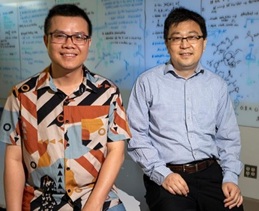Jennifer Laaser
Elasticity in rubbers and other polymer networks results from stretching of polymer chains at the molecular scale. Exactly which chains in a polymer stretch when a rubber is deformed, however, is not well understood. In a recent article in ACS Macro Letters (Preferential Mechanochemical Activation of Short Chains in Bidisperse Triblock Elastomers), Prof. Laaser’s group tackled this problem by labelling the chains in a self-assembled block copolymer with force-responsive molecules called mechanophores. Using selective labeling experiments, they showed that when the materials contain a mixture of short and long chains, it is the short chains that carry most of the force. The team is now working on extending this approach to chemically crosslinked polymers and hope to use the results to inform design of networks that can efficiently activate a wide range of force-driven chemical reactions.
Peng Liu
The Peng Liu group is using both quantum mechanics and molecular mechanics methods to study the mechanisms of stereoselective organic reactions catalyzed by engineered enzymes. Recent advancements in protein engineering allowed for efficient experimental development of new-to-nature reactions with repurposed enzymes, which promises to expand the reaction space of biocatalysis to activation modes unprecedented in biochemistry. The Liu group has implemented a workflow that incorporates different computational techniques to provide insights into the reaction mechanisms, selectivity-determining steps, and most importantly, how active site residues affect the interactions with the substrate and outcome of the catalytic reactions. These studies provide new understanding of how beneficial mutations impact reactivity, regio- and stereoselectivity.
The Liu group’s recent publication in collaboration with Yang at UC Santa Barbara (Nature, 2024) describes the mechanism of a photobiocatalytic oxidative coupling, which allows stereoselective synthesis of non-canonical amino acids. A computational model developed by Binh Khanh Mai, a postdoctoral researcher in the Liu group, elucidated the origins of the high levels of regio- and enantioselectivity via enzyme-controlled asymmetric intermolecular radical addition. In other recent publications from the Liu group (Nature Chem. 2024, Nature Synth. 2024, Science 2023, Nature Catal. 2023, JACS 2022, JACS 2022), computational methods were used to reveal how key mutations affect enzyme–substrate interactions and dynamic effects of transient radical intermediates in enzyme active site. In their current research, the Liu group is exploring innovative methods to more effectively utilize mechanistic insights to guide experimental design and discovery of new enzyme catalysts.


